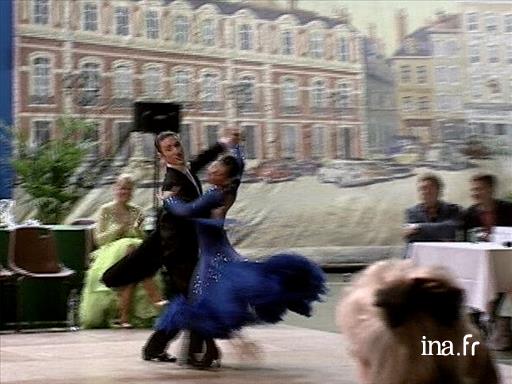Dancing madly, passionately

Information
Report devoted to dancesport in France, which compares two portraits of fans of this discipline and includes factual images of various competitions.
Some sacrifice everything for this discipline which needs to praticised like figure skating: with tenacity and rigor. In the whole of France, one hundred and thirty clubs are authorized to send candidates to the different competitions. People of all ages are eager to enroll at the clubs concerned.
Context
It was Camille de Rhynal, in 1909, who created the principle of the world couple dance championships, which he then named "standard dances.»
Travelling widely, after having applied for a patent in France, he did the same in all the countries of the world where he naturally stayed with the great aristocracy, and each time he filed a patent. It was the opportunity to spread his new concept and to gradually bring together many countries to increase his own importance. It was at this time that rules naturally began to appear, as well as a technique with its figures and steps laid down in writing to be performed according to a precise method. And it was the French who invented what we now call dancesport, as well as the foundations of what is still called international technique.
Towards the middle of the 20th century, Camille de Rhynal, now old and tired, sold all his rights to England, which led to progress being made in this branch. Dancesport is now listed among the activities recognized by the French Sports Ministry, but it has greatly regressed in recent decades, because the French gradually lost interest: too much focus is placed on the sporting side, and dancesport has lost much of its artistic direction.
Two branches make up these competitions today: international Latin including dances like samba, paso doble, rumba (or bolero), cha-cha-cha and the jive (or rock 'n' roll). International standard includes the quick Waltz, the slow Waltz, tango, slow foxtrot and quick-step (or quick Foxtrot).
Dancesport has already provoked and continues to provoke many controversies. On the one side, there are the fans of these competitions who are spread out across all the five continents. And on the other side, there are the critics who find the whole idea, starting with the concept of "dancesport", totally mind-boggling, stupid, ridiculous, outdated and even vulgar. The report shows quite well what this discipline of champions really means: a great deal of body work, countless hours of training -the technique is just as strict as for classical dance - hours spent trying to find and enrich the choreography. This is not including the sacrifice involved in terms of travelling (some travel abroad every weekend), and the effort that goes into creating the costumes, some of which are worthy of the greatest fashion designers.
In the report, our friend Nicolas expresses the happiness that he gets out of dancesport, as well as his rewarding experiences. He explains, quite honestly, that he thought he was a good dancer; that he had even won many awards, but undeservedly, because before really focusing on these dances in school, "he wasn't doing music.» The worst for a good dancer. But how many go down this path?
It is quite true that competitors in general, and particularly those in France, live in environments that are too closed off to have the perspective needed to advance these dances in their country, whatever their place of origin. The fact that these competitions are not liked by certain people does not alter the fact that on an international level, a very large number of dancers have taken immense joy out of competing for more than a century. One example: the largest competition in the world takes place, once a year in May, in Blackpool, a small seaside resort in the North West of England.
This competition is called the British OPEN, meaning that it is open to the world, in contrast to the World Championships, where each country can only be represented by its best two couples. This immense competition, composed of amateurs and professionals, under-18s and adults, dancers performing «Latin American» dances and 'standard' dances, show-dance, demonstrations, and formations (choreographies for twelve or sixteen couples performed to a musical medley), has taken place each year since 1920, with only one exception during the war. Every time, it welcomes thousands of participants from dozens of countries around the world. And to give just one example, if you want to participate in the standard dances competition, since it is "open to the world", you will find yourself in a group of more than a 1,000 couples who will have to perform several times before the judges, and on several different days before the final.
Only a few dancesport competitions that are broadcast on certain television channels seem to exist today, for the mainstream French public in any case, in addition to televised celebrity dance shows, a trend from England that also spread around the world.
Not everyone likes classical dance, and contemporary dance is not exactly everybody's cup of tea. But this is the very essence of art. Isn't the important thing that there is something for everyone?





